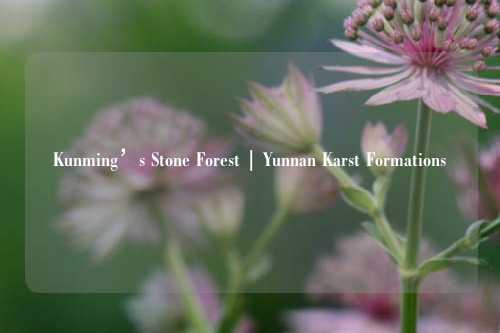Kunming’s Stone Forest | Yunnan Karst Formations
The Majestic Karst Landscape of Kunming’s Stone Forest
Nestled in the southern part of China’s Yunnan Province, Kunming’s Stone Forest stands as one of the most iconic and awe-inspiring natural landscapes in the country. Known for its striking limestone formations that resemble a petrified forest, this UNESCO World Heritage site has been shaped by millions of years of natural processes. The Stone Forest, or "Shilin," as it is called in Chinese, features towering stone pillars that create an otherworldly scene, making it a must-visit for nature lovers, geologists, and photographers alike.
The site’s unique geological formations are the result of karst processes that have been ongoing for over 270 million years. The vast expanse of jagged stone formations rises dramatically from the ground, creating a labyrinth of narrow pathways and secretive, hidden chambers. Visitors to the Stone Forest are often left spellbound by the way the rocky spires seem to stretch toward the sky, as if frozen in time. For those interested in geology, the Stone Forest offers a rare opportunity to witness the evolution of karst landscapes and the power of nature to shape the earth’s surface.

Geological Significance and Formation
The creation of Kunming’s Stone Forest is a testament to the immense forces of nature that have shaped the Yunnan region over geological time. The area is part of the larger karst landscape that covers much of Southeast Asia, a region famous for its limestone formations, caves, and sinkholes. Over millions of years, the region’s karst topography was formed by the erosion of soluble rocks, such as limestone, by water, wind, and chemical processes.
The Stone Forest is a prime example of karst erosion, where water slowly wore away the soft limestone, leaving behind sharp, spire-like formations that rise up from the earth like petrified trees. These formations, called "stone pillars," stand as tall as 30 meters in some areas and are densely packed, creating a visual effect reminiscent of a forest made entirely of stone. The site is divided into several areas, each with its own unique features and geological characteristics. The formations vary in shape, size, and height, offering a variety of views that change depending on the light and the perspective from which they are viewed.
In addition to the stone pillars, the Stone Forest is home to a network of caves and underground streams that add to the complexity of the karst system. Some caves are deep and narrow, while others are wide and spacious, offering visitors an opportunity to explore the hidden wonders beneath the surface. The interplay between above-ground rock formations and subterranean landscapes creates a dynamic and ever-evolving environment that highlights the geological significance of the site.
The Cultural and Mythological Legacy of the Stone Forest
While the Stone Forest is renowned for its geological beauty, it also holds deep cultural and mythological significance for the local Sani people, an ethnic group of the Yi minority in Yunnan. According to Sani folklore, the Stone Forest is said to be the remains of a once-thriving forest that was turned to stone by a powerful goddess. Legend has it that a beautiful and kind-hearted young girl fell in love with a handsome young man, but the couple's love was forbidden by the gods. In their sorrow, the girl prayed to the gods to protect their love, and as a result, the forest where they once played was transformed into stone.
This myth has been passed down through generations, and the locals continue to believe that the Stone Forest is imbued with magical qualities. Visitors to the site can learn about these stories through local guides, who often share the legends of the Stone Forest as part of the cultural experience. The mythological connection to the land adds an extra layer of fascination to the site, providing a glimpse into the rich spiritual and cultural traditions of the Sani people.
The Sani people have long lived in the shadow of the Stone Forest, and their traditions, including music, dance, and festivals, are intertwined with the landscape. The annual Torch Festival, held by the Yi people, is one of the most significant cultural events in the area. During the festival, people gather to celebrate the harvest and pay tribute to their ancestors, with traditional dances and songs that honor the spirits of the land. The Stone Forest serves as the backdrop to many of these celebrations, further deepening the connection between the landscape and the cultural identity of the Sani people.
A Maze of Stone Paths and Scenic Views
The Stone Forest is not just a visual marvel but also an outdoor adventure waiting to be explored. The area is crisscrossed by a network of winding paths that take visitors through the towering stone spires, offering countless opportunities for photography and exploration. These paths allow for intimate encounters with the formations, as visitors can wander through the narrow passages, step into hidden chambers, and marvel at the various shapes and sizes of the stone pillars.
The experience of walking through the Stone Forest is one of discovery and wonder. As visitors make their way through the labyrinth of stone, the landscape constantly changes, revealing new perspectives of the towering formations. The light filtering through the cracks between the stones creates shifting shadows and highlights, further enhancing the beauty of the site. From certain vantage points, visitors can look out over the entire Stone Forest and take in sweeping views of the surrounding hills and valleys.
For those interested in hiking, the Stone Forest offers several trails that range in difficulty. Some paths are easy and suitable for casual strolls, while others lead to higher vantage points, providing a bird’s-eye view of the surrounding karst landscape. Climbing the stone spires themselves can also be an exciting challenge, though it is advisable to do so with a guide, as the terrain can be slippery and uneven in places.
The Flora and Fauna of the Stone Forest
The Stone Forest is not just a geological wonder; it also hosts a variety of plant and animal life. The region’s unique climate and topography create an environment where species of plants and animals thrive in an unusual and diverse ecosystem. The area surrounding the Stone Forest is covered in lush vegetation, including evergreen trees, shrubs, and colorful wildflowers that bloom during the spring and summer months.
Birdwatchers will find plenty to appreciate in the Stone Forest as well, as the area is home to a variety of bird species, including eagles, vultures, and smaller songbirds. The presence of these birds adds to the charm of the landscape, as they soar above the stone pillars and perch on the rocks, offering a striking contrast to the towering limestone formations.
In addition to birds, the Stone Forest is home to various mammals, reptiles, and insects. The local wildlife is well-adapted to the karst landscape, and visitors may catch glimpses of animals such as foxes, rabbits, and lizards. The dense vegetation and rocky terrain provide ample shelter for these creatures, making the area a haven for nature enthusiasts and wildlife photographers.
Accessibility and Visitor Facilities
Kunming’s Stone Forest is easily accessible from the city of Kunming, the capital of Yunnan Province. The site is about 90 kilometers from Kunming, and visitors can reach it by bus, car, or organized tour. The journey from Kunming to the Stone Forest takes about two hours, making it a convenient day trip for those staying in the city.
Once at the Stone Forest, visitors will find a range of facilities to enhance their experience. There are well-marked trails, viewing platforms, and rest areas throughout the site, making it easy for visitors to explore at their own pace. The area also features a visitor center where guests can learn more about the history, geology, and cultural significance of the site. For those interested in guided tours, knowledgeable local guides are available to provide in-depth explanations and share insights into the history and mythology of the Stone Forest.
Accommodations near the Stone Forest range from basic guesthouses to more luxurious hotels, offering options for both short visits and longer stays. Local restaurants serve traditional Yunnan cuisine, and visitors can sample regional specialties such as rice noodles, spicy hotpot, and fresh vegetables grown in the fertile land surrounding the Stone Forest.
A Natural Wonder and Cultural Treasure
Kunming’s Stone Forest is more than just a scenic attraction; it is a place where natural beauty, geological wonder, and cultural heritage come together. The striking limestone formations create a landscape that feels both timeless and surreal, while the myths and legends surrounding the site give it a deeper spiritual significance. For visitors, the Stone Forest is an opportunity to explore one of the most unique landscapes in the world, to learn about the geological processes that shaped it, and to connect with the rich cultural traditions of the Sani people.
Whether you are a nature lover, a history enthusiast, or a photographer seeking stunning landscapes, Kunming’s Stone Forest offers a truly memorable experience. The combination of breathtaking natural beauty, cultural richness, and the timeless appeal of this karst wonderland ensures that it will remain one of China’s most captivating destinations for years to come.
















